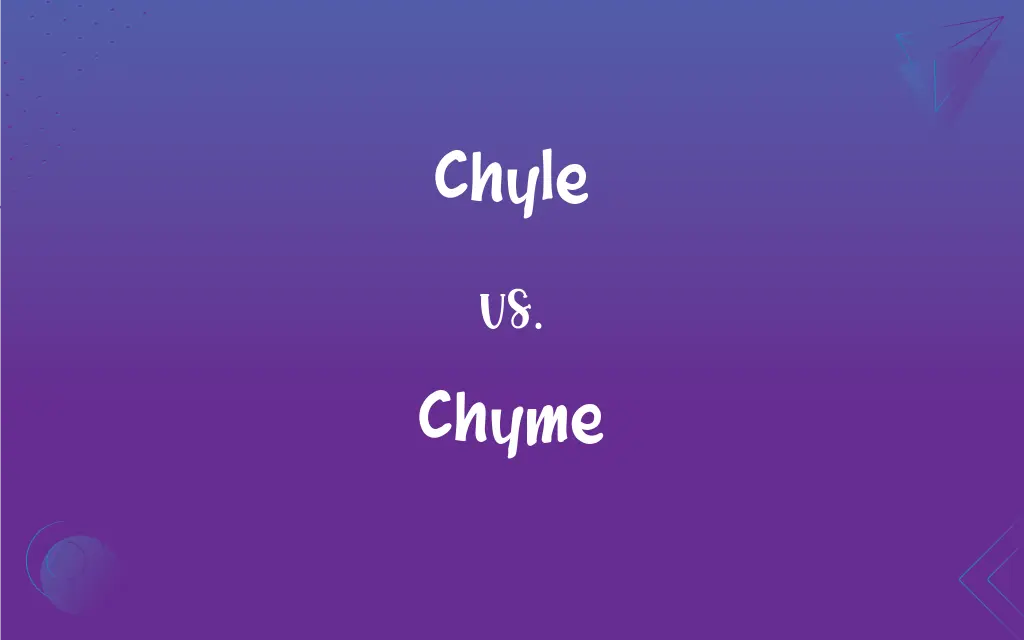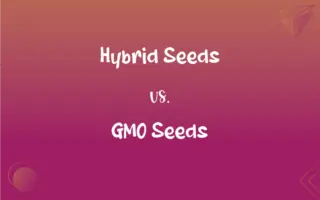Chyle vs. Chyme: What's the Difference?
Edited by Aimie Carlson || By Harlon Moss || Updated on October 27, 2023
Chyle is a milky bodily fluid consisting of lymph and emulsified fats, absorbed from the intestines during digestion. Chyme is a semi-fluid mass of partly digested food expelled by the stomach into the duodenum.

Key Differences
Chyle is a fluid in the lymphatic system, whereas chyme is a substance in the digestive system.
The formation of chyle involves the absorption of fats, while chyme is formed from the mechanical and chemical breakdown of food.
Chyle is known for its milky appearance, whereas chyme has a semi-fluid, pasty consistency.
The main function of chyle is to transport fats, whereas chyme facilitates further digestion and absorption of nutrients.
Chyle is transported through the lymphatic system, whereas chyme moves through the gastrointestinal tract.
ADVERTISEMENT
Comparison Chart
Part of Speech
Noun
Noun
Word Origin
Greek (chylos)
Greek (chymos)
Plural Form
Chyles
Chymes
Related Terms
Chylomicron, Chylothorax
Chymification, Chymotrypsin
Usage in Biology
Lymphatic system, Fat absorption
Digestive process, Gastric contents
ADVERTISEMENT
Chyle and Chyme Definitions
Chyle
Nutrient-rich lymphatic fluid.
The presence of chyle indicates successful fat absorption.
Chyme
A semi-fluid mass of partly digested food.
Chyme is slowly released into the small intestine.
Chyle
Lymph enriched with emulsified fats.
Chyle is formed during the digestion of fatty foods.
Chyme
A mixture of food, saliva, and gastric juices.
Chyme moves from the stomach to the duodenum for further digestion.
Chyle
The fluid in the lymphatic system after intestinal absorption.
Chyle transports lipids and vitamins to the circulatory system.
Chyme
Partially digested food expelled by the stomach.
The pyloric sphincter regulates the flow of chyme.
Chyle
A milky fluid containing fats, absorbed from the intestines.
The doctor explained that chyle carries nutrients to the bloodstream.
Chyme
The result of stomach's mechanical and chemical digestion.
Chyme is essential for nutrient absorption in the intestines.
Chyle
A digestive byproduct rich in lipids.
Chyle has a distinct milky appearance due to its fat content.
Chyme
The contents of the stomach after digestion.
Chyme is acidic and contains digestive enzymes.
Chyle
A milky fluid consisting of lymph and emulsified fat extracted from chyme by the lacteals during digestion and passed to the bloodstream through the thoracic duct.
Chyme
The thick semifluid mass of partly digested food that is passed from the stomach to the duodenum.
Chyle
A digestive fluid containing fatty droplets, found in the small intestine.
Chyme
The thick semifluid mass of partly digested food that is passed from the stomach to the duodenum.
Chyle
A milky fluid containing the fatty matter of the food in a state of emulsion, or fine mechanical division; formed from chyme by the action of the intestinal juices. It is absorbed by the lacteals, and conveyed into the blood by the thoracic duct.
Chyme
The pulpy mass of semi-digested food in the small intestines just after its passage from the stomach. It is separated in the intestines into chyle and excrement. See Chyle.
Chyle
A milky fluid consisting of lymph and emulsified fats; formed in the small intestine during digestion of ingested fats
Chyme
A semiliquid mass of partially digested food that passes from the stomach through the pyloric sphincter into the duodenum
FAQs
Where is chyme formed?
In the stomach.
Can chyle be blocked?
Yes, leading to conditions like chylothorax.
Do both chyle and chyme aid in digestion?
Indirectly, chyle aids in nutrient transport; chyme directly aids in digestion.
What happens to chyle after digestion?
It's transported via the lymphatic system to the circulatory system.
What happens to chyme after the stomach?
It enters the small intestine for further digestion and absorption.
Is chyle always milky?
Yes, due to its fat content.
What does chyme contain?
Partially digested food, gastric juices, and enzymes.
Are there diseases related to chyle?
Yes, like chyluria and chylous ascites.
What is chyme?
A semi-fluid mass of partly digested food from the stomach.
Where is chyle found?
In the lymphatic system.
What's the main function of chyle?
To transport fats and nutrients to the bloodstream.
What's the consistency of chyme?
Semi-fluid and pasty.
How is chyle formed?
Through intestinal absorption of fats.
How is chyme created?
By the mechanical and chemical breakdown of food in the stomach.
Can chyme be problematic?
Yes, issues like acid reflux involve chyme.
Are there conditions affecting chyme?
Yes, like gastritis affecting its composition.
What is chyle?
A milky fluid containing lymph and emulsified fats.
Is chyle part of the immune system?
Indirectly, as the lymphatic system plays a role in immunity.
What does chyme do?
Facilitates digestion and absorption of nutrients.
What does chyle transport?
Fats and fat-soluble vitamins.
About Author
Written by
Harlon MossHarlon is a seasoned quality moderator and accomplished content writer for Difference Wiki. An alumnus of the prestigious University of California, he earned his degree in Computer Science. Leveraging his academic background, Harlon brings a meticulous and informed perspective to his work, ensuring content accuracy and excellence.
Edited by
Aimie CarlsonAimie Carlson, holding a master's degree in English literature, is a fervent English language enthusiast. She lends her writing talents to Difference Wiki, a prominent website that specializes in comparisons, offering readers insightful analyses that both captivate and inform.































































